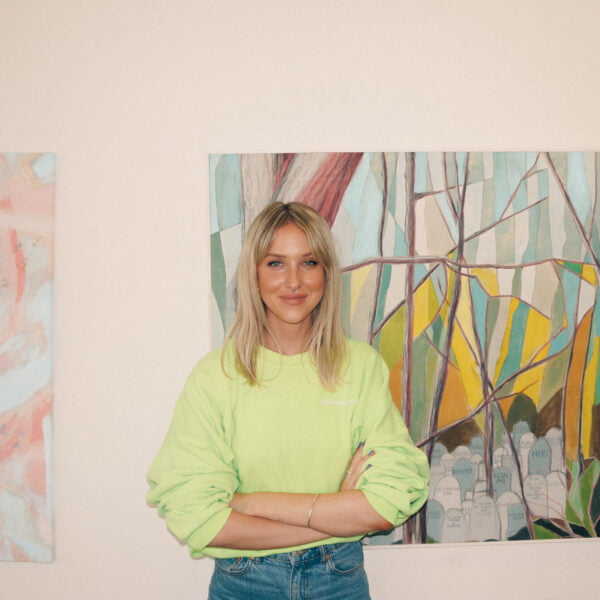
Natasha Collie
Senior Brand Marketing Manager at Penguin Random House UK
At the start of the year, Ladybird Books approached Sonder & Tell with a dream brief. In 2021, a year that’s been particularly challenging for...
In conversation with
Co-Founders Of Duzi Studio

We are an agency dealing with words, and we often find ourselves pushing for their value over design. We also know from working with Ella and Char, co-founders of Duzi Studio, that the very best branding comes from a solid understanding between the two.
We’ve worked with Duzi on projects like Comfort Zones and clients like Ayla Swim and Birdsong and it’s our shared love of storytelling and a respect for one another’s craft that has continued to bring us together, in spite of our different mediums.
When Duzi reached out and asked if we wanted them to design a bespoke print for Sonder & Tell to support their creative initiative The Dolly Effect, we jumped at the chance. You can buy our ‘Rules For Writing’ print here, with all proceeds going to Magic Breakfast, a London-based charity providing food to vulnerable families so children don’t miss out on an education.
To celebrate the launch we’ve spoken to Duzi about supporting freelancers, how words inform design and why Dolly Parton is the ultimate muse.
The Dolly Effect is a female-led, creative event series directly inspired by Dolly Parton’s awe-inspiring success and loveable character. Although it sounds a little wacky at face value, the initiative strives to encourage women from all corners of the creative industry to have confidence in their talent and their voice. The contrasting degrees of self-confidence and vulnerability that it takes someone to perform in front of an audience inspires and motivates The Dolly Effect’s wider community — we are seeing more and more women reaching out to us asking to have a place on the stage.
TDE launched as a live event series, however with social distancing in place, we’ve had to put a lot of thought behind how we could support our community from a distance. So we’ve taken Dolly digital in a bid to support the many freelancers in our community who have been negatively impacted during these times. The Dolly Effect Print Store now sells limited edition prints with all the proceeds going to the artist who designed it. The response has been overwhelmingly positive, and we can see this aspect of the initiative existing long after lockdown is lifted.


Dolly Parton is not only an incredibly successful, self made, female icon, but she also remains unapologetically true to herself. She presents no illusions – she is honest, accepting and to the point; she makes mistakes and learns from them. And alongside all of that, she’s damn talented and enjoys doing it. The mission behind The Dolly Effect initiative is spoken most accurately by Dolly herself — “figure out who you are, then do it on purpose”.
The design industry landscape sees a lot of female designers drop off after studying a degree, with the numbers going from a 70% majority at university to only 0.1% of creative agencies being female-founded. Although this wasn’t the reason we started Duzi, it has become an integral part of our brand vision and output. We want to bring a female edge to the brands we collaborate with; an edge that brings an alternative perspective and challenges the brand as much as it supports them.
We believe that the ongoing partnerships and personal relationships we build with our clients is the reason that many brands might come to Duzi. Their successes are our successes, and their failures are our failures; we are there to grow and develop as the brand does.

Storytelling plays a hugely important role in our work — when you successfully combine beautiful design with a meaningful story, the end result will be engaging and memorable for the audience. A brand’s story holds more significance now than it has ever before; brand culture is evolving and humankind is disengaging with mass market products, chains and trends. Instead, we crave authentic, purpose-driven brands that have a narrative our values align with. We hold the belief that good design will elevate stories of this kind and help contribute to positive change.
Definitely — there is nothing more frustrating than when people assume design is just colouring in! Words and concepts are the starting point of any visual identity. It may be straightforward to create something that is aesthetically pleasing, but to create something timeless and meaningful is a different ball game. Throughout the process, a brand’s story and their graphics need to be considered in equal measure, therefore, before we begin designing any visuals, we will first work hard to fine tune the brands foundations and purpose so that it is clear and digestible for the consumer.
No matter how pretty the end-product might be, it won’t survive in our current socially conscious consumer environment if the story and purpose behind it are blurred.
One of the biggest challenges is ensuring the process is understandable and digestible for clients, some of who may never have gone through a visual identity process before. When you are studying, or are a junior in an agency, the people you are presenting the work to understand the process inside out. However, when you are client-facing there is a certain amount of education and reassurance that needs to be included in the process (something they don’t teach you in training!). Throughout the process, it is key to manage the brand’s expectations, whilst also explaining to them that it is just as helpful to understand what isn’t resonating with them, as much as what is. Ensuring a client puts their brand first when making any design decisions, and avoiding any personal preferences, is imperative for the bigger picture and future of the business. We tell our clients to try and consider ‘what is successful, not what you like’.
Something we struggle with is pre-designed or package brand identities that are sold as a finished piece online, with the exception of swapping in the correct brand name. These often follow design trends and feel like a quick fix for brands in a hurry. But a bespoke identity requires substance and a deeper level of design thinking that isn’t included when buying into a product with a single click. This feels like a disservice both to the intelligence behind the design industry, and the client who will undoubtedly have to rebrand at a later date.

Design{h}ers, published by viction:ary in 2019, is a brilliant book that showcases female designers across a range of disciplines. The book feels hopeful and is inspirational from a business perspective. We would recommend it for any young female designers.
The most valuable books are often those which you least expect. We try to pick up anything we can, from garden tips and tricks to recipe books; from novels to newspapers. It doesn’t have to be prescriptively creative to trigger new and exciting ideas. Put down your phone and take time to go through some good old fashioned books once in a while! There is no better time than now to do so.
Duzi's Storylist

Senior Brand Marketing Manager at Penguin Random House UK
At the start of the year, Ladybird Books approached Sonder & Tell with a dream brief. In 2021, a year that’s been particularly challenging for...

Founder Of Simple Politics
Talking about serious issues doesn’t mean defaulting into a serious tone of voice, or using complicated language. If anything, accessibility, clarity and a touch of...

Brand & Community Manager at Homethings
Creating a tone of voice from scratch can be challenging. But a blank slate to work from also mean there’s room for something a bit...

Content Editor for Natoora

Writer & Curator